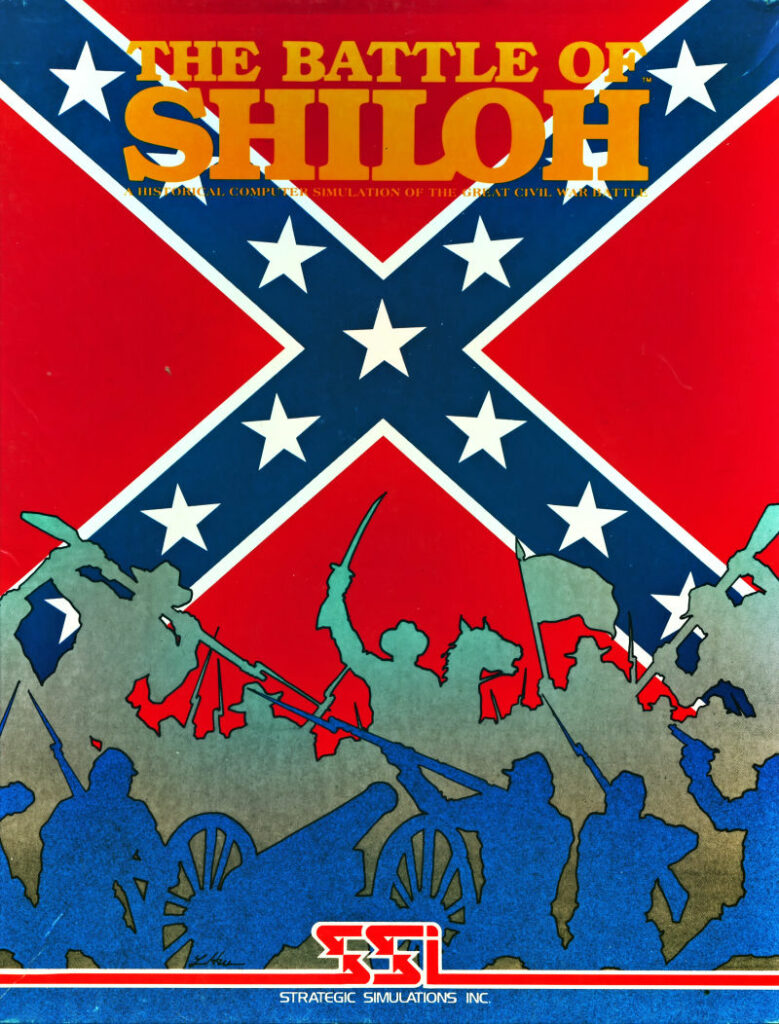
– Lieutenant Narwhal, for your next mission you will take command of the Confederate Army in the American Civil War!
– Confederate Army... Yes, I believe I can do it. I can wear the role, physically and mentally.
– Perfect! Any question?
– Yes Sir. By “Civil War”, do you mean “the War of Northern Aggression?”

The Battle of Shiloh is the other game released by David Landrey and Charles Kroegel (together the Tactical Design Group) in 1981, at the same time as Tigers in the Snow.
If you are American, you know what the Battle of Shiloh is. If you are not, the Battle of Shiloh happened in early April 1862 : Grant’s Army of the West Tennessee was waiting to combine with Buell’s Army of the Ohio, in order to invade the Confederacy using the Tennessee river as his supply route. Before Buell could arrive however, the Confederate Army of the Mississippi led by generals A.S. Johnston and P.G.T. Beauregard fell on Grant who had poorly prepared his defenses. The battle of Shiloh thus happened in two acts :
- The first day (6th of April), Grant is slowly pushed back toward the river, with the day ending in a desperate defense of the landing site : Pittsburgh Landing
- As Buell’s forces arrived during the night, the second day (7th of April) saw the combined Union force retaking the lost ground, until Beauregard, the only surviving Confederate general, ordered a retreat.
In addition to its strategic aspect, the battle of Shiloh was a pivotal point in Grant and Sherman’s respective careers, and caused more casualties then the rest of the Civil War combined up to that point, making it one of the most famous battles of the war.
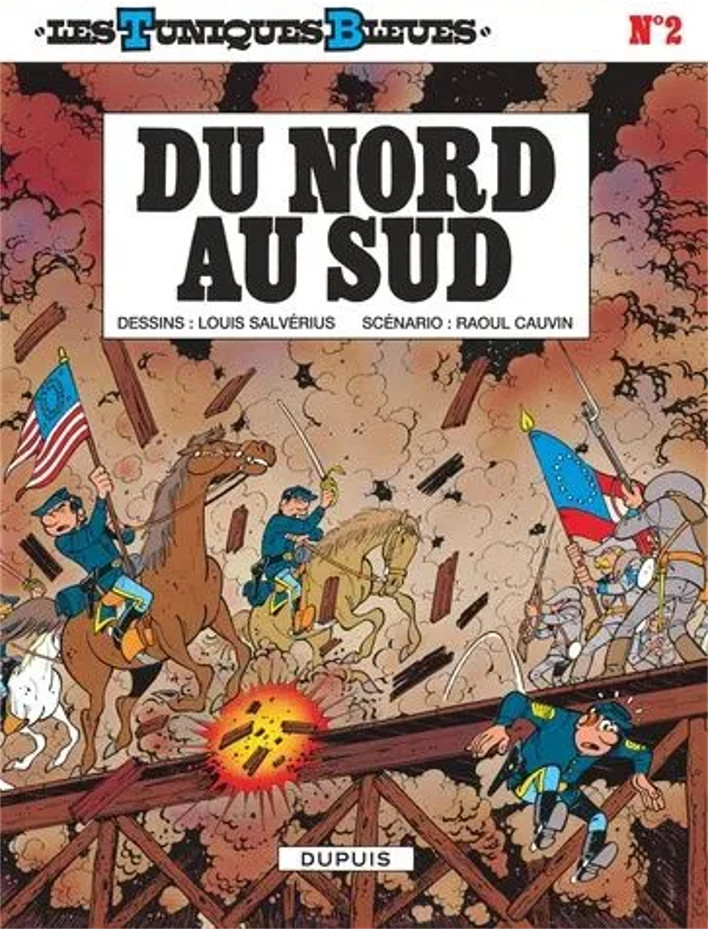
The Battle of Shiloh was also covered by the Data Driven Gamer, he played it as the Union so I am going to play as the Confederacy, giving a small advantage to the other side.
The game opens on this situation :
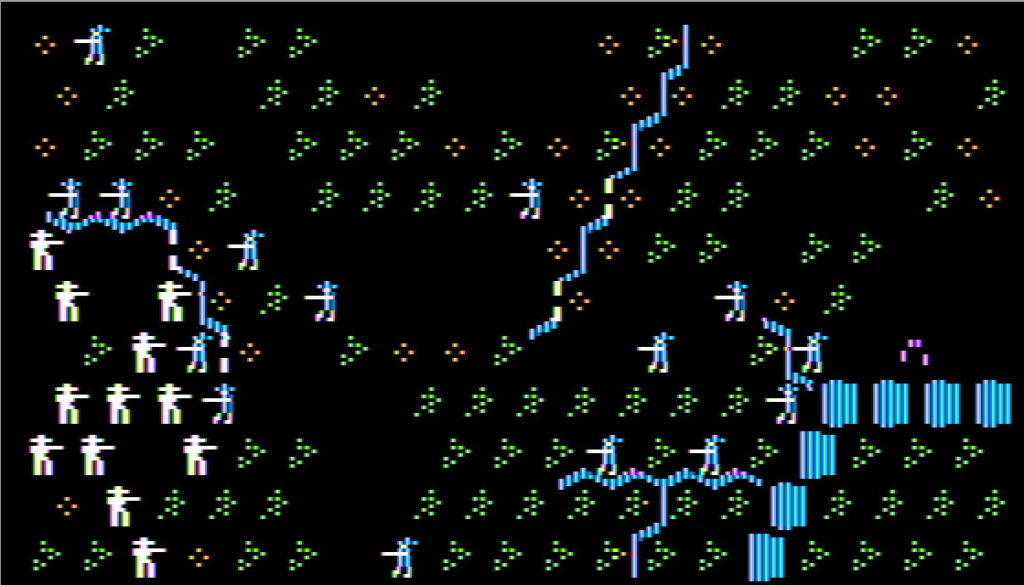
The Confederates are on the left, and they have an initial advantage as they are grouped (because they caught the Union flat-footed) and are slightly more numerous. Of course, they need to leverage this as soon as possible because during the night the Union will receive very significant reinforcements.
The game starts with an artillery barrage, where for every enemy unit in contact with one of your units you can allocate 1 to 3 “artillery points”, from a pool that regenerates each artillery phase. Damage is minimal, but it adds up turn after turn.

After that, it is time for the Confederates to pick targets for their assault. I decide not to assault everywhere I can : pushing the Blues with my attacks would actually help them create a defensive line. I much prefer to attack strategically in locations where pursuits will allow me to pass behind my enemy.
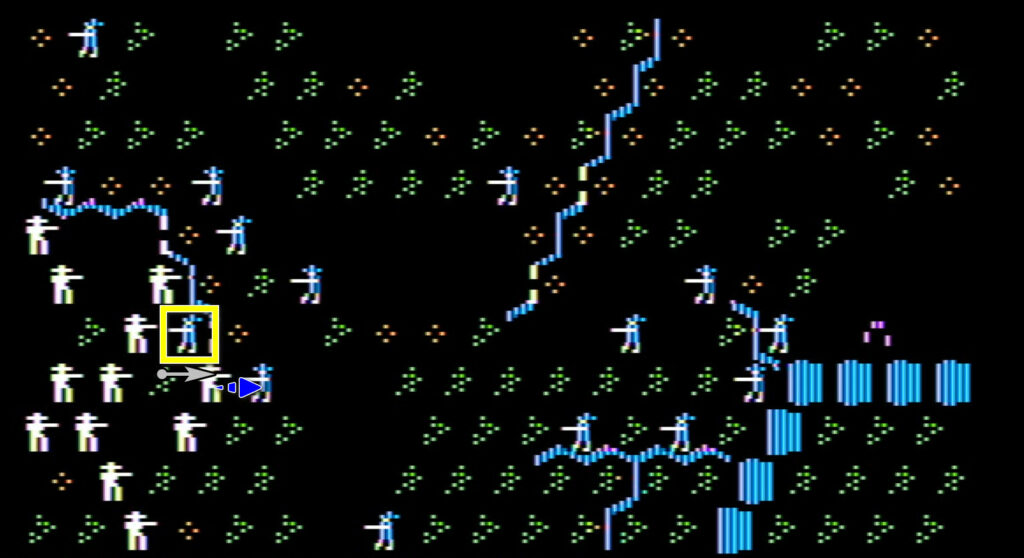
And already it is the Yankees’ turn. As expected, they pull back.

And I pursue. Frustratingly, one of my attempts to isolate one enemy brigade in the North by chasing the unit behind it fails because my unit “did not receive attack orders” due to bad leadership and/or morale.
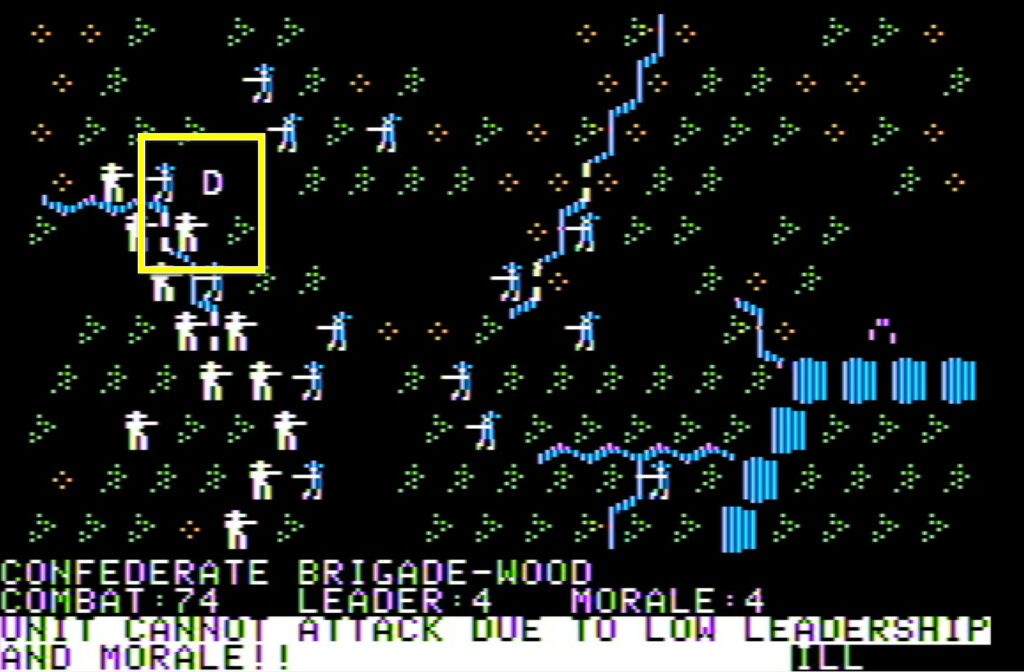
And that sets the tone for the first half of the game : I advance, they withdraw. Sometimes, I catch and destroy a straggling unit. More often, I catch it but it retreats through my zones of control, at the cost of extra damage.
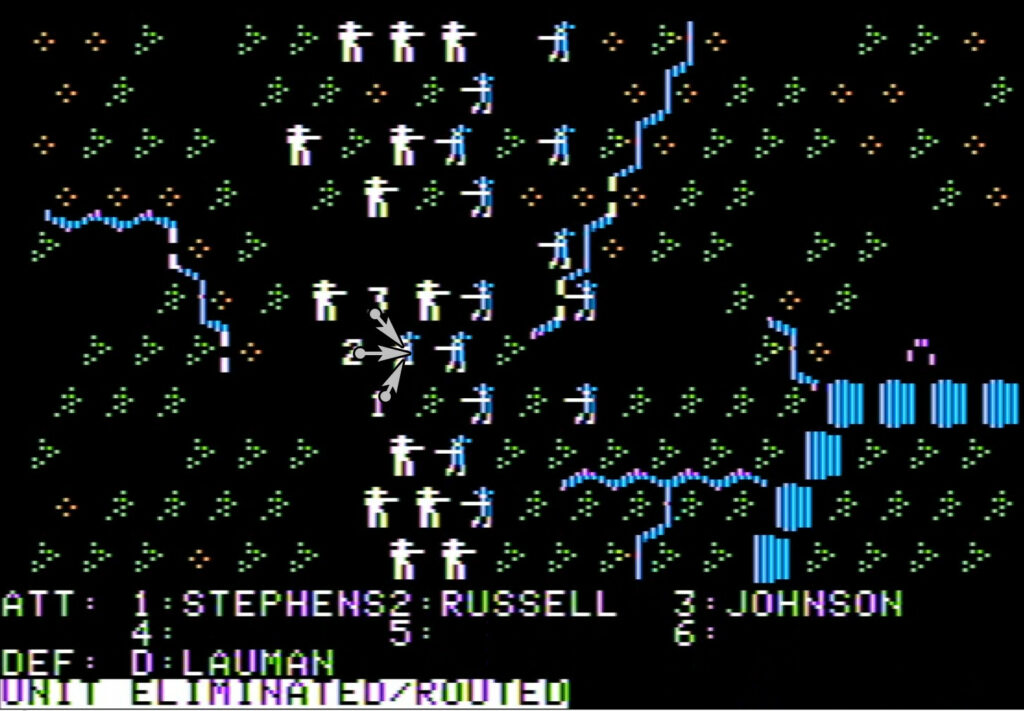
End of turn 5 :
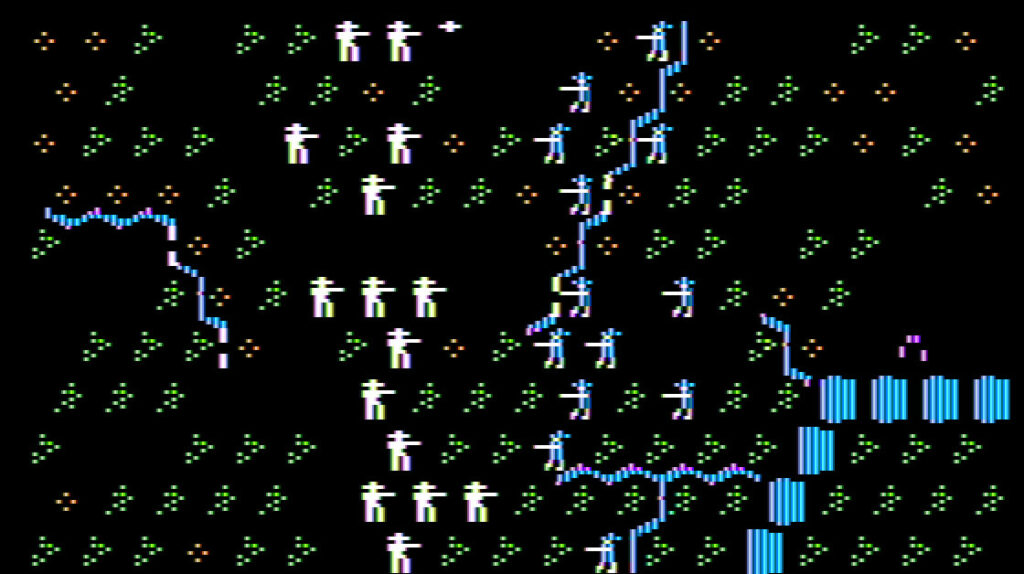
End of turn 7. Even though they had a well organized line they did not bother defending along the water line.

At the end of turn 8 Grant finally decides to make a stand. It is not a bad place for that, given the front is so narrow that my number advantage is pretty much nullified.

Grant’s problem is that his units are so packed that they cannot retreat when defeated. Many are destroyed this way :
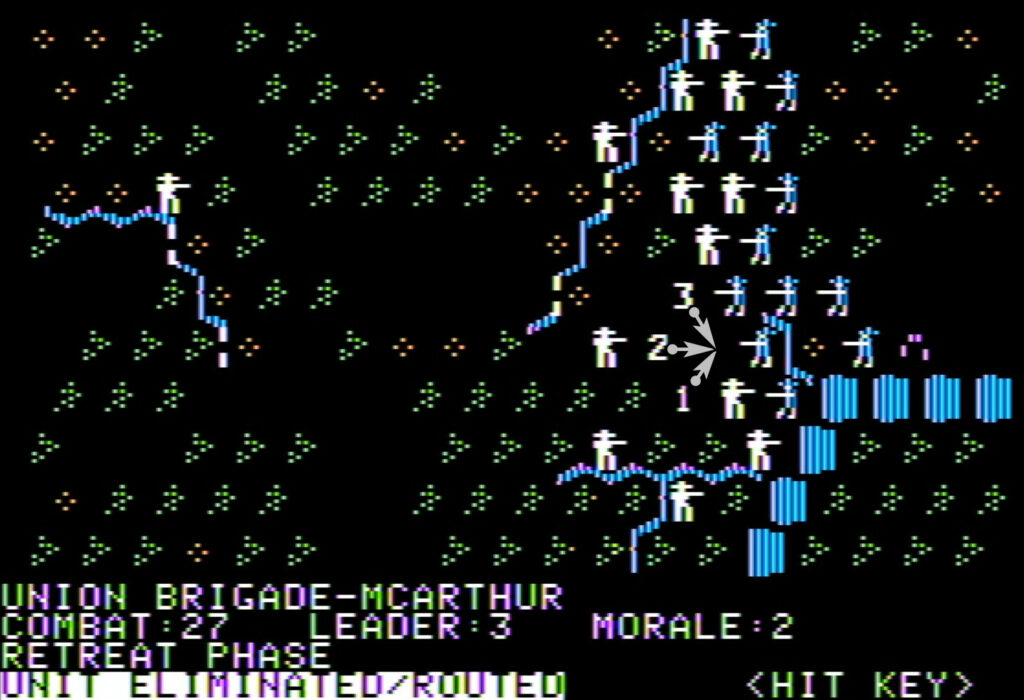
Turn 10 the first reinforcements start to arrive, replacing some of Grant’s losses. On the other hand, his line has been penetrated in several places, so I believe I have a bit of time left to destroy some more of his depleted units :

Turn 11 I am even in position to initiate a turning movement in the North :
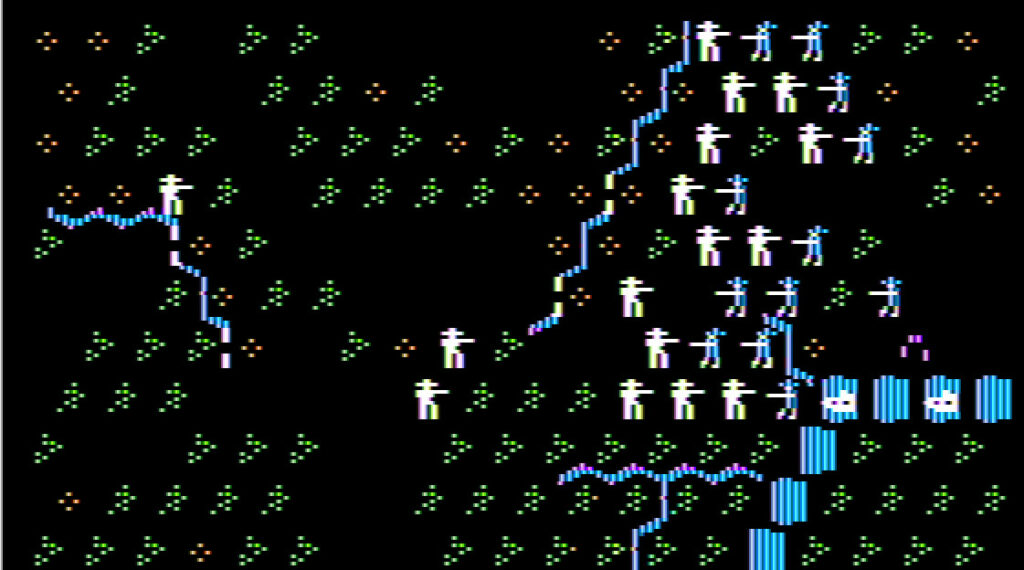
And suddenly, turn 12, Buell’s full army arrives. That’s my cue to skedaddle !
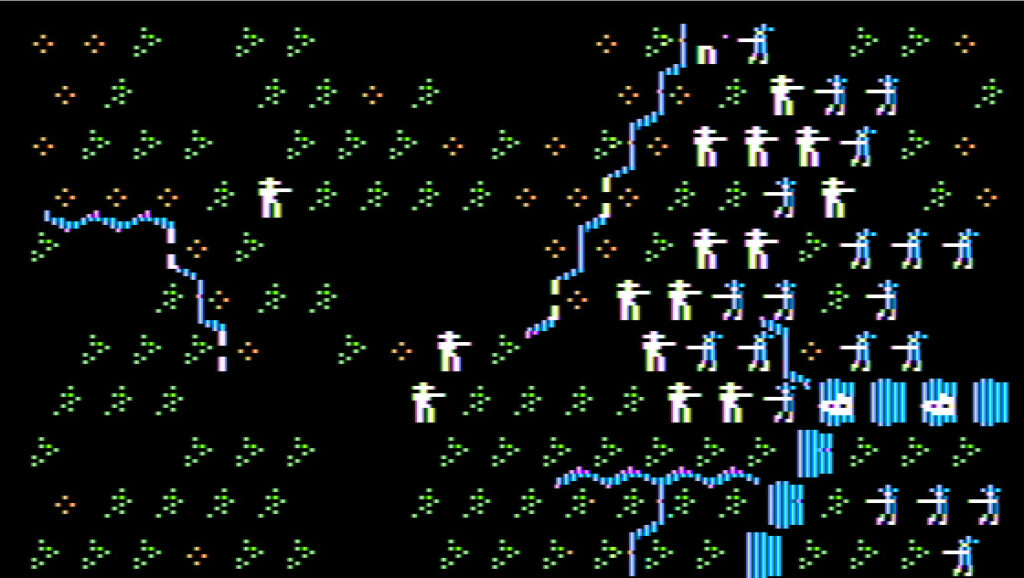
Some of them immediately spawn on the “correct” side of the river. The others will have to cross, but given I don’t control the crossing area this is very easy for them to do.
And so now the dynamic of the game changes : I am doing what the German newsreel in 1944 would call an “elastic defense”. End of turn 14 below :
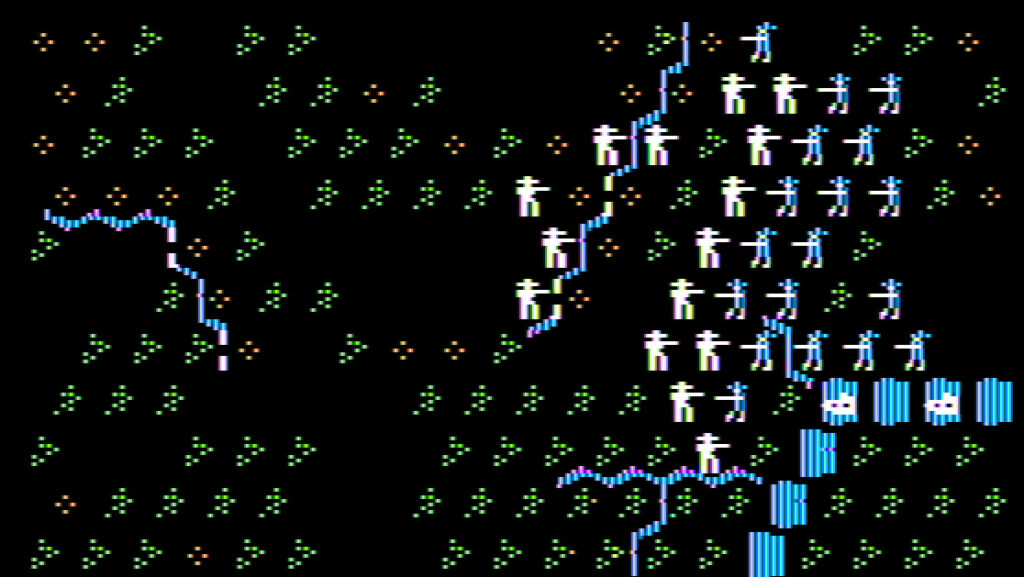
End of turn 16, I have lost 3 brigades already as those were very depleted by early combat and around 30 phases of artillery !
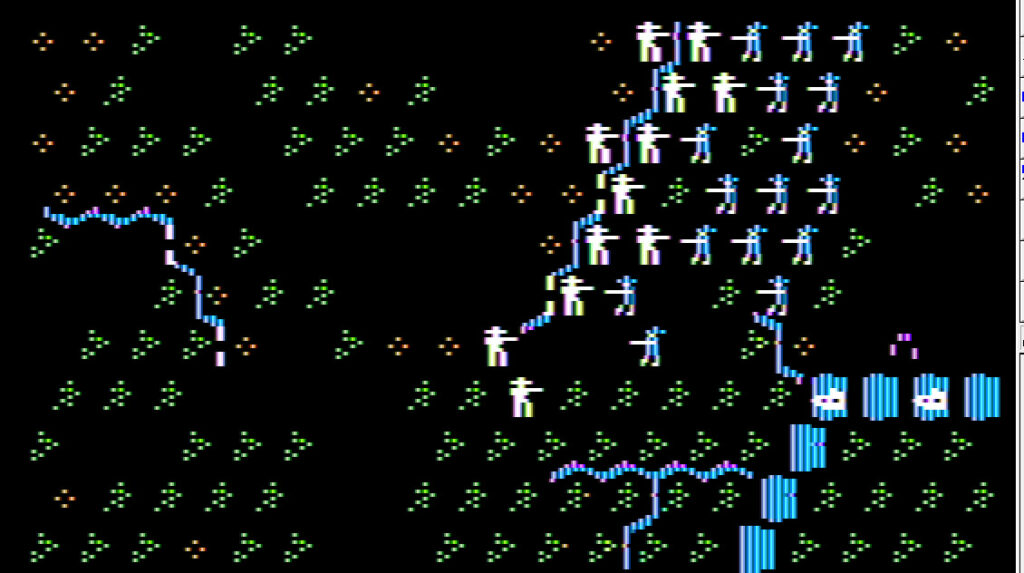
Turn 17 I start defending along that stream of water. The Blues attack vigorously, losing more men than I do, but my weakened units are destroyed.
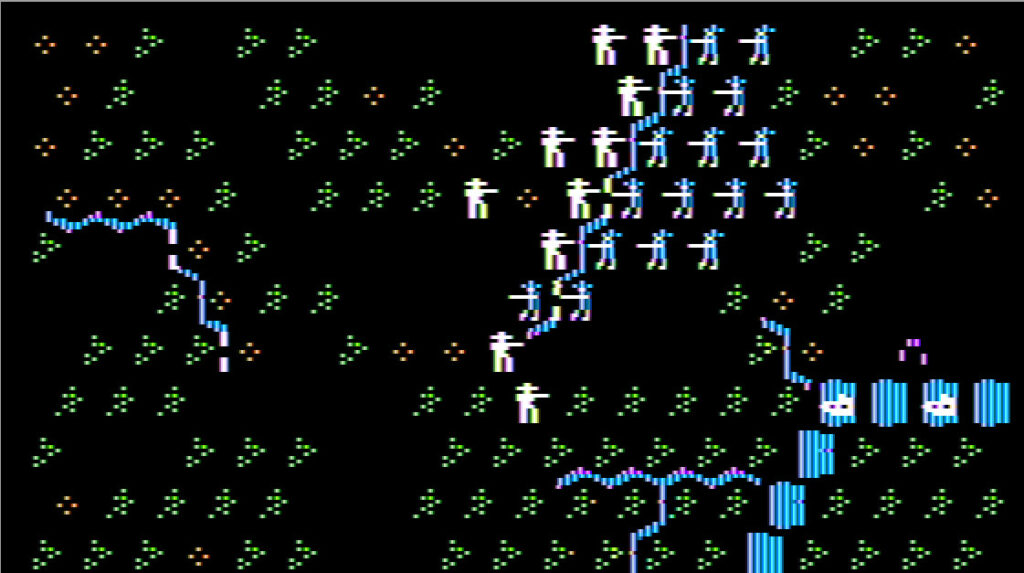
Turn 18, the Union manages to cross in force, the situation is desperate …
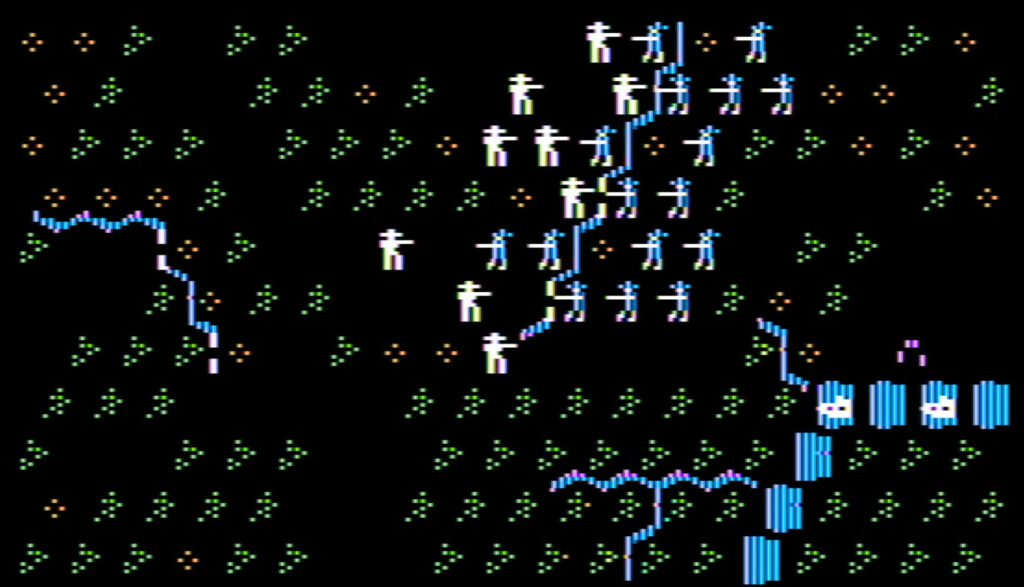
… except it was the last turn and I win on points. It may be a marginal victory, but with some luck Grant gets demoted and they replace him with Buell !
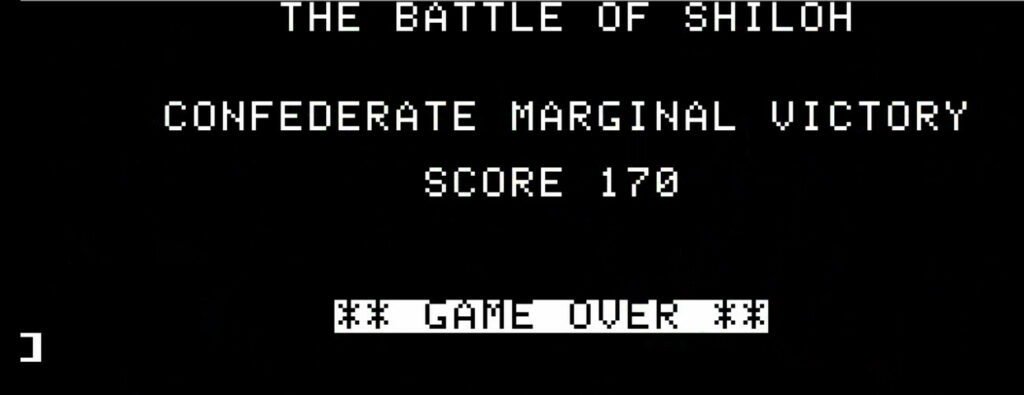
Rating & Review
The Battle of Shiloh by the Tactical Design Group, published by SSI, USA
First release : October 1981 on Apple II and Atari
Tested on : Apple emulator
Total Hours Tested : 2.5 hours
Average duration of a battle: >1 hour
Difficulty: Easy (1/5)
Would recommend to a modern player : No
Would recommend to a designer : No
Final Rating: Totally obsolete
A lot of my earlier comments on Tigers in the Snow apply to the Battle of Shiloh : same release date, same (low) price, same limited content in the box, and same simultaneous release on TRS-80.
Unlike Tigers in the Snow though, the Battle of Shiloh only received one subsequent port on Atari 800, which I wasn’t able to play :
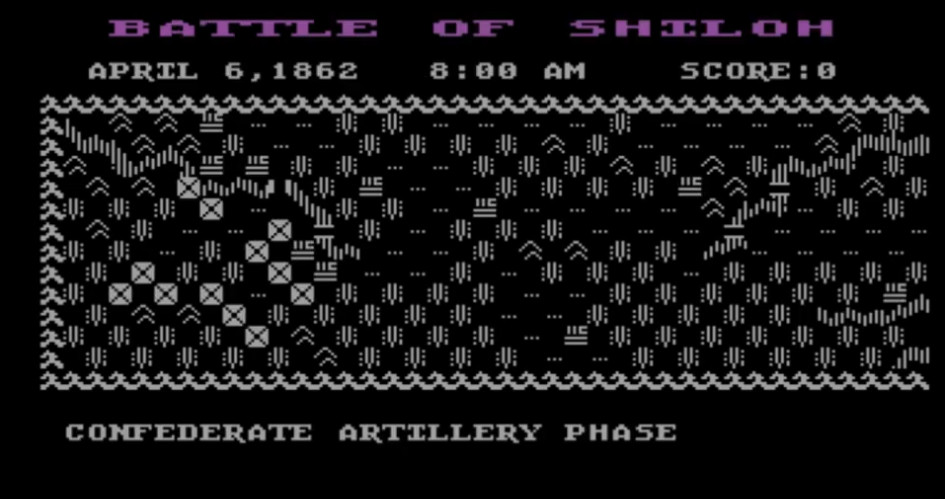
Once again, the TRS-80 and the Apple II version differ significantly – the TRS-80 version is in my opinion a bit better. I would have done an AAR on the TRS-80 version, but the TRS-80 is also a lot harder to read visually, and the TRS-80 emulator does not accelerate the game as much as the Apple II one does – and boy is this game slow at historical speed !
A. Immersion
The manual has slightly more context than Tigers in the Snow, with this “Historical Commentary”:
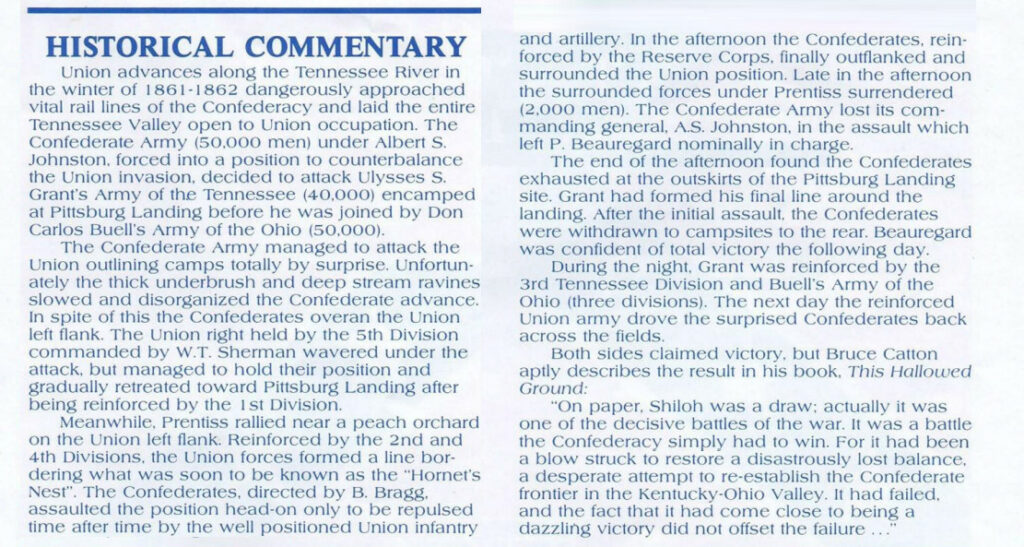
Unfortunately, the events mentioned in the commentary, like the Hornet’s Nest and how it saved the Union, are conspicuously absent from the game.
The manual also comes with a complete order of battle :
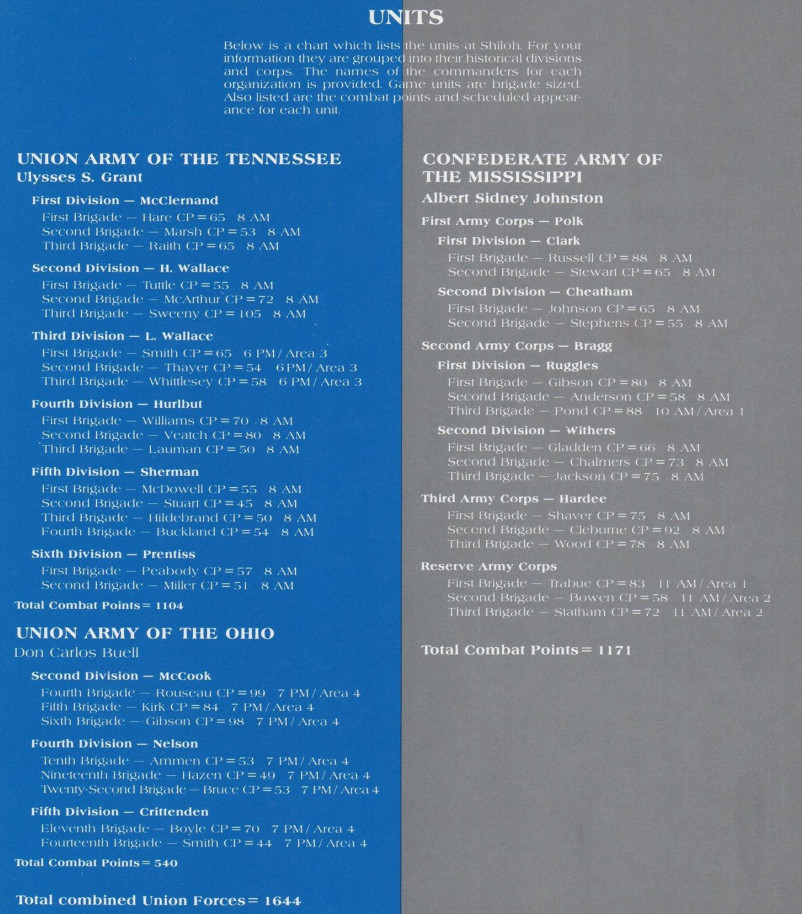
Overall, the game is too simple to be immersive : only one kind of unit (infantry !), except the river barges whose only purpose is to project a zone of control. Artillery is totally off-map, and a lot of factors (morale, leaders) are notionally there but you have no control over them anyway so at the end of the day you never pay attention to them. Tigers in the Snow was a Bulge-flavored game, this is a Shiloh-flavored game at best.
As for graphics, the only positive thing I can say is that at least the Apple II version has graphics, because the TRS-80 one does not :
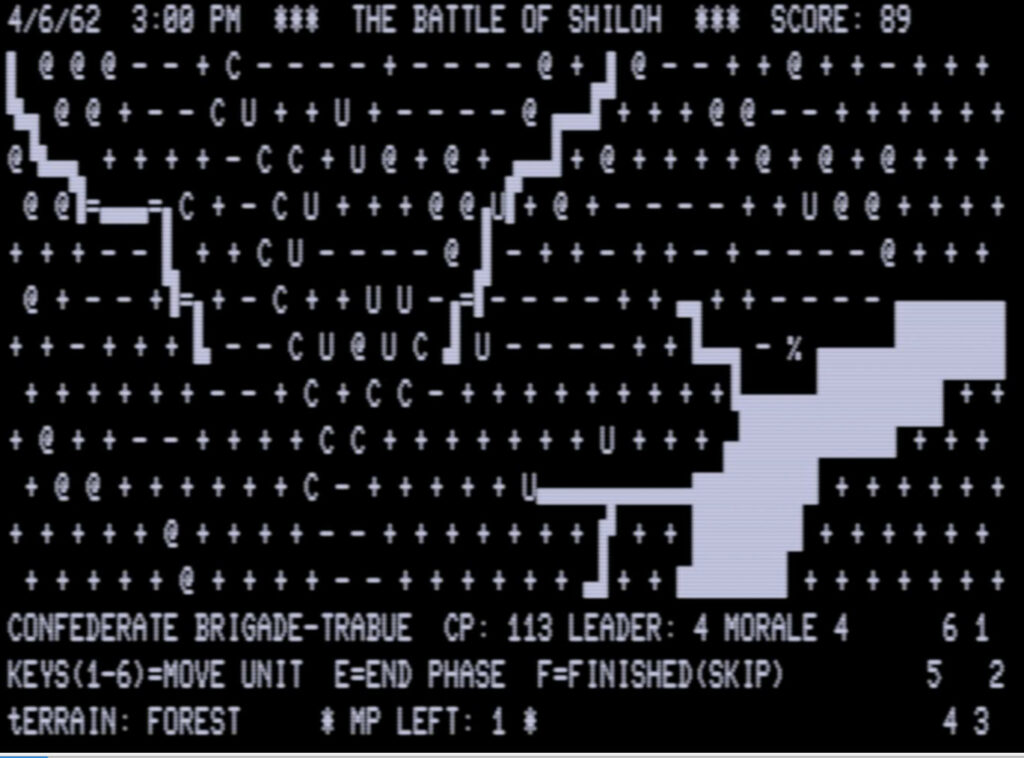
Rating : Very bad
B. UI , Clarity of rules and outcomes
The Battle of Shiloh uses the same engine as Tigers in the Snow (movement of all units, then attack with all enemy units proposed one after the other) and as such it has exactly the same problems :
- At any given moment, you can only see the combat value of units you are cycling through, making it very hard to know where are the weak spots of either side,
- The manual is unclear about the effect of the various type of attacks,
With four artillery phases before you can move your units (Union then Confederacy before the Union turn, Confederacy then Union before the Confederacy turn), the game is also slower between two turns as it keeps cycling through units.
Yet, the end result is marginally better than in Tigers in the Snow for several reasons :
- Unlike Tigers in the Snow, the game cycles through your units twice for movement, so you can use the first cycle to check the stats of your units (and move those units blocking the way),
- You get to see the combat value of enemy units as you cycle through them during the numerous artillery phases – at least those in range,
- Unit combat values are a lot more standardized, at least before taking into account damage, so there are a lot fewer surprises.
So, unlike Tigers in the Snow this is a mitigated disaster. Still :
Rating : Terrible
C. Systems
Again, the game is very similar to Tigers in the Snow, with a few differences that overall improve the game :
- As I said, you can cycle twice through units ! Game changer.
- No supply or fuel to “manage” ; in Tigers in the Snow the feature was poorly designed as it was impactful but you did not have any real control over it,
- Much simplified movement rules : no complex rules depending on unit type and side when entering enemy zones of control (you just stop), no random cost crossing water, …
There are few additions too :
- As above, artillery is not used during combat but in a specific phase,
- In addition to an attack / defense strategy, you can also choose the level of risks in the attack. Sadly, what that does is not clear from the manual : I believe it increases the variability of the results, whereas the Data Driven Gamer understood it as increasing the casualties for both sides…
- Units have morale and leadership – units with better morale and leaders have a bonus in combat value, move a bit faster and are less likely to disregard your orders. Sadly, you don’t have much control on either. Morale goes up when you win combats and down when you lose them, leadership changes randomly when a leader is killed during battle (this also decreases morale).
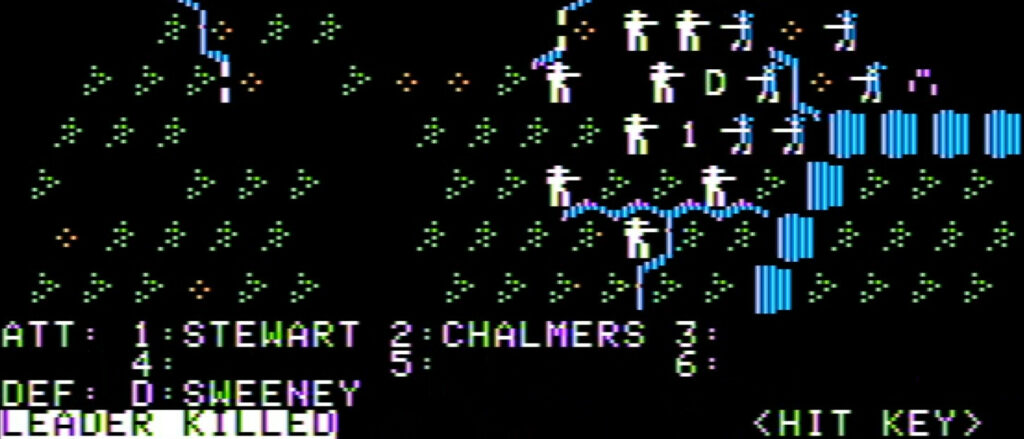
In my opinion, morale and leadership do not bring anything to the game, since you don’t really have an impact on them – and keep in mind that you cannot check the morale and leadership of your units on the fly anyway.
As for artillery, it is impactful as a constant drain of combat value but it has a negligible impact in any given turn (it does 1-4 damage to targeted units – most units start at 55 – 75 in combat value). Given that you cannot really focus your artillery for a decisive assault and that it hits both sides roughly equally, is it really worth it to have 4 artillery phases every turn ? I don’t think so.
Rating : Very bad
D. Scenario design & Balancing
There are only 2 scenarios (a short one and a long one) that seem balanced. Overall, they are less frustrating to play than Tigers in the Snow as the movement is less often blocked by rivers or a low roll on movement points, but still there are not many opportunities for tactical shenanigans as it is extremely easy for the Union to build a solid frontline, after that the game is just about trading blows in the most efficient manner.
That’s for Apple II anyway. The TRS-80 scenario is much better due to three differences :
- The map is larger,
- The small rivers are not between two tiles but are tiles themselves,
- The Confederacy moves first (instead of just attacking first)
This gives a lot more opportunities to the Confederacy to turn the Union forces, who cannot just move horizontally while avoiding all combat.
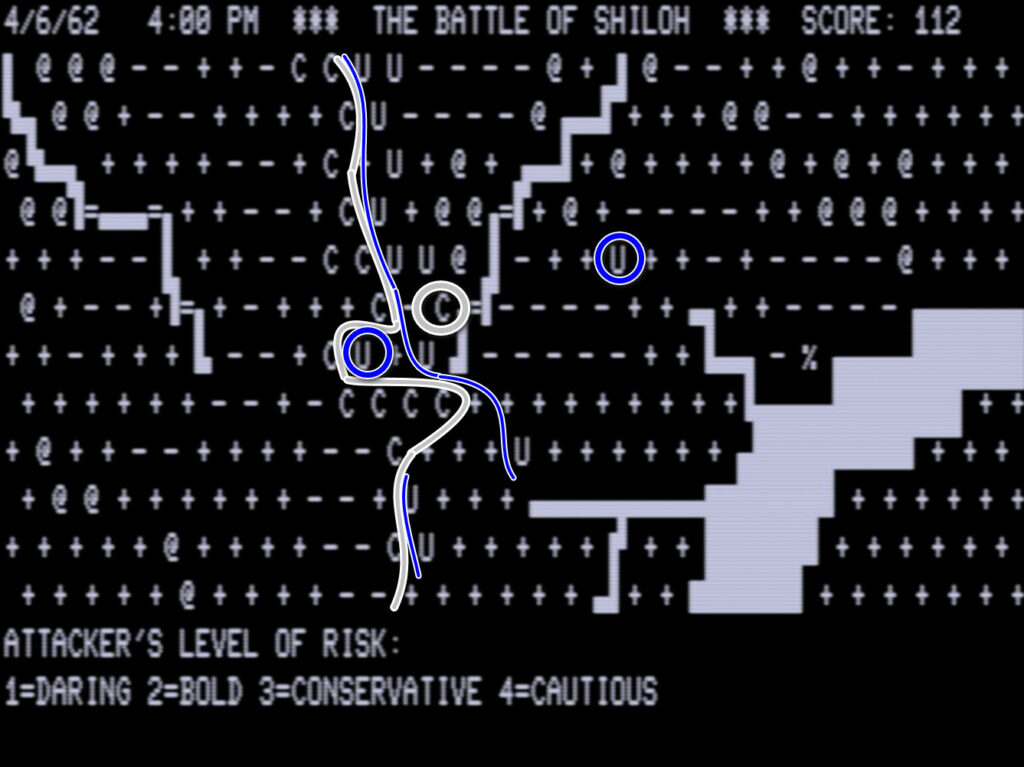
I believe the TRS-80 version is much harder for the Union (which can be balanced by giving it extra combat value when setting the scenario), but it is also a lot more interesting.
Nothing special to say about the AI : it does its job.
Rating : Very bad
E. Did I make interesting decisions ?
Not really. I probably took a few interesting tactical decisions here and there, but for a battle that lasted one hour, not enough to be worth it. At least, those decisions are less often ruined by a random number generator than in Tigers in the Snow.
F. Final rating
Flawed and obsolete. Better than Tigers in the Snow though.
Contemporary Reviews
The Battle of Shiloh received a much better reception than Tigers in the Snow. Softtalk in February 1982 calls it a “good beer and pretzels tactical game“, though simpler than other SSI games. Bob Proctor in Computer Gaming World (January 1982) stated that “The game is absorbing; you are constantly making decisions and watching for weaknesses in the enemy” though he complained about the weakness of the AI and how it was cheating with extra speed, and of course this “certainly produces drastic differences in strategy in what is primarily a game of maneuver“. The game aged well-enough that in its 1990 wargame retrospective, Computer Gaming World still gave it 3 out of 5 stars.
But those reviews are nothing compared to the one of Softside issue #39 (Mike Shadick and Sallie Stephenson) that is so over-the-top enthusiastic they might as well be reviewing another game. It starts strongly : “especially outstanding is the animated map of the Tennessee Valley“, and I may as well let you read the rest :

Again, French players had to rely on the sole opinion of Tilt, which did not like the game very much in March 1984 (2/6). Possibly this is partly due to the intrinsic quality (or lack thereof) of the game, partly due to the Civil War not being a very popular topic in France – maybe that latter reason is why I seem to have liked the game a lot less than the Data Driven Gamer did ?